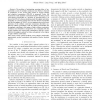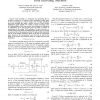INFOCOM
2012
IEEE
12 years 9 months ago
2012
IEEE
Abstract—The problem of minimizing queueing delay of opportunistic access of multiple continuous time Markov channels is considered. A new access policy based on myopic sensing a...
ICASSP
2011
IEEE
13 years 10 months ago
2011
IEEE
In this paper, we present experiments on continuous time, continuous scale affective movie content recognition (emotion tracking). A major obstacle for emotion research has been t...
JMLR
2010
14 years 1 months ago
2010
A continuous time Bayesian network (CTBN) uses a structured representation to describe a dynamic system with a finite number of states which evolves in continuous time. Exact infe...
JMLR
2010
14 years 1 months ago
2010
We present a continuous time Bayesian network reasoning and learning engine (CTBN-RLE). A continuous time Bayesian network (CTBN) provides a compact (factored) description of a co...
JAIR
2010
14 years 1 months ago
2010
Intrusion detection systems (IDSs) fall into two high-level categories: network-based systems (NIDS) that monitor network behaviors, and host-based systems (HIDS) that monitor sys...
AUTOMATICA
2008
14 years 7 months ago
2008
: Given a continuous time nonlinear closed loop system, we investigate sampled
AUTOMATICA
2010
14 years 7 months ago
2010
: The standard continuous time state space model with stochastic disturbances the mathematical abstraction of continuous time white noise. To work with well defined, discrete time ...
UAI
2003
14 years 8 months ago
2003
Continuous time Bayesian networks (CTBN) describe structured stochastic processes with finitely many states that evolve over continuous time. A CTBN is a directed (possibly cycli...
ARTS
1997
Springer
14 years 11 months ago
1997
Springer
We introduce a mathematical model of the timed behaviour of components with streams as input and output using a hierarchy of timing concepts. We distinguish non-timed streams, dis...
ISCAS
2005
IEEE
15 years 13 days ago
2005
IEEE
Abstract— Time encoding is a mechanism for representing the information contained in a continuous time, bandlimited, analog signal as the zero-crossings of a binary signal. Time ...



